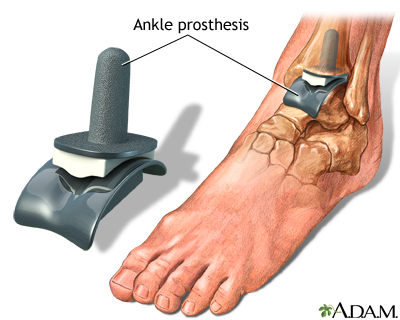Health Library
Ankle replacement - discharge
Ankle arthroplasty - total - discharge; Total ankle arthroplasty - discharge; Endoprosthetic ankle replacement - discharge; Osteoarthritis - ankle
Images

I Would Like to Learn About:
Definition
You had surgery to replace your damaged ankle joint with an artificial joint. This article tells you how to take care of yourself when you go home from the hospital.
When You're in the Hospital
You had an ankle replacement. Your surgeon removed and reshaped damaged bones, and put in an artificial ankle joint.
You received pain medicine and were shown how to treat swelling around your new ankle joint.
What to Expect at Home
Your ankle area may feel warm and tender for 4 to 6 weeks.
You will need help with daily chores such as driving, shopping, bathing, making meals, housework for up to 6 weeks. Be sure to check with your health care providers before you return to any of these activities. You will need to keep weight off of the foot for 10 to 12 weeks. Recovery can take 3 to 6 months. It may take up to 6 months before you return to normal activity levels.
Activity
Your provider will ask you to rest when you first go home. Keep your leg propped up on one or two pillows. Place the pillows below your foot or calf muscle. This helps reduce swelling.
It is very important to elevate your leg. Keeping it above heart level will reduce swelling. Swelling can lead to poor wound healing and other surgery complications.
You will be asked to keep all weight off of your foot for 10 to 12 weeks. You will need to use a walker or crutches. You can also use a knee scooter to avoid putting weight on your ankle.
- You will need to wear a cast or a splint. Take the cast or splint off only when your provider or physical therapist says it is OK.
- Try not to stand for long periods.
- Do the exercises your doctor or physical therapist showed you.
You will go to physical therapy to help your recovery.
- You will start with a range of motion exercises for your ankle.
- You will learn exercises to strengthen the muscles around your ankle next.
- Your therapist will slowly increase the amount and type of activities as you build strength.
Do not start heavier exercises, such as jogging, swimming, aerobics, or bicycling, until your provider or therapist tells you it is OK. Ask your provider when it will be safe for you to return to work or drive.
Wound Care
Your sutures (stitches) will be removed about 1 to 2 weeks after surgery. You should keep your incision clean and dry for 2 weeks. Keep your bandage on your wound clean and dry. You may change the dressing every day if you like.
Do not shower until after your follow-up appointment. Your provider will tell you when you can begin taking showers. When you do start showering again, let the water run over the incision. Do not scrub.
Do not soak the wound in the bath or a hot tub.
Pain
You will receive a prescription for pain medicine. Get it filled when you go home so you have it when you need it. Take your pain medicine when you start having pain so the pain does not get too bad.
Taking ibuprofen (Advil, Motrin) or another anti-inflammatory medicine may also help. Talk to your provider about what other medicines you can take with your pain medicine.
When to Call the Doctor
Contact your provider if you notice:
- Bleeding that soaks through your dressing and does not stop when you put pressure over the area
- Pain that does not go away with your pain medicine
- Swelling or pain in your calf muscle
- Foot or toes that appear darker or are cool to the touch
- Redness, pain, swelling, or yellowish discharge from the wound sites
- Fever that is higher than 101°F (38.3°C)
- Shortness of breath or chest pain
- Your ankle feels unstable or out of position
Related Information
OsteoarthritisRheumatoid arthritis
Ankle replacement
Bathroom safety for adults
Surgical wound care - open
Preventing falls
References
Bettin CC. Ankle arthrodesis. In: Azar FM, Beaty JH, eds. Campbell's Operative Orthopaedics. 14th ed. Philadelphia, PA: Elsevier; 2021:chap 11.
Wexler D, Campbell ME, Grosser DM, Kile TA. Ankle arthritis. In: Frontera WR, Silver JK, Rizzo TD Jr, eds. Essentials of Physical Medicine and Rehabilitation. 4th ed. Philadelphia, PA: Elsevier; 2019:chap 82.
BACK TO TOPReview Date: 12/12/2022
Reviewed By: C. Benjamin Ma, MD, Professor, Chief, Sports Medicine and Shoulder Service, UCSF Department of Orthopaedic Surgery, San Francisco, CA. Also reviewed by David C. Dugdale, MD, Medical Director, Brenda Conaway, Editorial Director, and the A.D.A.M. Editorial team.
 | A.D.A.M., Inc. is accredited by URAC, for Health Content Provider (www.urac.org). URAC's accreditation program is an independent audit to verify that A.D.A.M. follows rigorous standards of quality and accountability. A.D.A.M. is among the first to achieve this important distinction for online health information and services. Learn more about A.D.A.M.'s editorial policy, editorial process and privacy policy. A.D.A.M. is also a founding member of Hi-Ethics. This site complies with the HONcode standard for trustworthy health information: verify here. |
The information provided herein should not be used during any medical emergency or for the diagnosis or treatment of any medical condition. A licensed medical professional should be consulted for diagnosis and treatment of any and all medical conditions. Links to other sites are provided for information only -- they do not constitute endorsements of those other sites. © 1997- 2023 A.D.A.M., a business unit of Ebix, Inc. Any duplication or distribution of the information contained herein is strictly prohibited.
